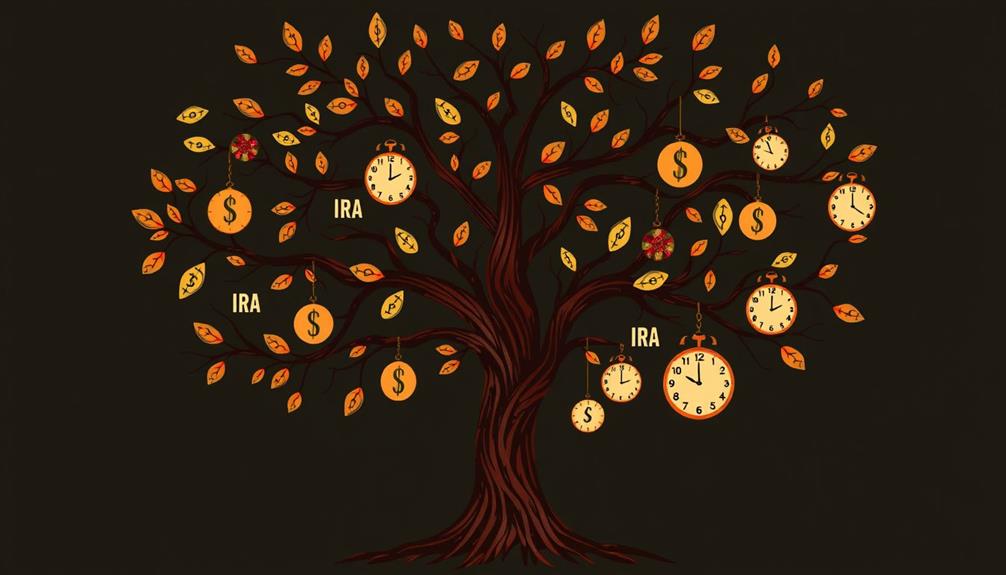When it comes to inheriting an IRA, it is crucial to have a full understanding of the rules in order to avoid costly penalties. The guidelines vary depending on whether you are a spouse or a non-spouse beneficiary. Spouses have the option to treat the IRA as their own, whereas non-spouse beneficiaries are required to adhere to the 10-year payout rule outlined in the SECURE Act. Failing to grasp these timelines could result in significant tax implications and penalties. Additionally, it is important to note that traditional IRAs are subject to taxes on withdrawals, while Roth accounts offer tax-free access. Being well-informed about these fundamentals is key to effective financial planning, and there is further information available on strategies that can maximize your inheritance.
Key Takeaways
- Understand the different distribution rules for designated beneficiaries, especially between spouses and non-spouses under the SECURE Act.
- Non-spouse beneficiaries must withdraw all assets within 10 years to avoid penalties; minor children and disabled beneficiaries have exceptions.
- Traditional IRA withdrawals are subject to ordinary income tax; Roth IRA withdrawals are tax-free, impacting financial planning.
- Timely withdrawals help manage taxable income and avoid jumping into higher tax brackets, making strategic planning essential.
- Consult financial professionals to navigate RMD compliance and optimize withdrawal strategies tailored to your situation.
Overview of IRA Types

When it comes to Individual Retirement Accounts (IRAs), understanding the different types can greatly influence your retirement planning. You've got two main options: the traditional IRA and the Roth IRA.
With a traditional IRA, you can deduct contributions from your taxable income, but you'll need to pay taxes when you withdraw funds during retirement. This can be a great strategy if you expect to be in a lower tax bracket later on. Additionally, it's important to reflect on common financial terms that can help clarify your investment strategies.
On the other hand, a Roth IRA allows you to contribute after-tax dollars, meaning your withdrawals during retirement are tax-free. This can be especially beneficial if you anticipate being in a higher tax bracket in the future.
One critical aspect to contemplate is required minimum distributions (RMDs). Traditional IRAs require you to start taking RMDs by age 72, which can impact your retirement income strategy. In contrast, Roth IRAs don't have RMDs during your lifetime, allowing your investments to grow tax-free for a longer time.
Understanding these differences is essential, particularly when dealing with an inherited IRA. Choosing the right type can greatly affect how you manage your retirement funds and optimize tax implications.
Key Inherited IRA Rules

When you inherit an IRA, understanding the beneficiary types is essential, as it affects your distribution options and timelines.
Different types of IRAs, such as Gold IRAs offered by reputable companies like Noble Gold, may have specific rules that impact your choices.
You'll need to take into account the tax implications based on whether you're a spouse, non-spouse, or meet certain exceptions.
Let's break down these key inherited IRA rules to guarantee you make informed decisions.
Beneficiary Types Explained
Understanding the nuances of beneficiary types is essential for effectively maneuvering inherited IRAs. When you're named as a designated beneficiary in the IRA documentation, the distribution rules markedly impact your options after the owner's death.
Surviving spouses enjoy unique advantages; they can treat inherited IRAs as their own, which allows them to bypass the SECURE Act's 10-year distribution rule that applies to non-spouse beneficiaries. Additionally, beneficiaries should consider diversifying their inherited assets, potentially exploring options like a Gold IRA rollover for long-term growth and protection against market volatility.
If you're a non-spouse beneficiary, you must adhere to the SECURE Act's 10-year payout rule. This means you'll need to fully withdraw the inherited IRA assets by December 31 of the 10th year following the owner's death.
However, there are exceptions to this rule. For instance, if you're a minor child of the IRA owner, you can take distributions under different guidelines until you turn 21. Additionally, beneficiaries with disabilities may also qualify for different rules.
It's worth noting that if you're not more than 10 years younger than the IRA owner, you might find exemptions from the 10-year payout rule as well. Understanding these inheritance rules helps you navigate your options effectively.
Distribution Timelines Overview
Steering the distribution timelines for inherited IRAs can greatly influence your financial strategy.
If you're a non-spouse beneficiary, you'll need to follow the 10-year payout rule, which mandates that you withdraw all assets by December 31 of the 10th year after the owner's death. This is a critical aspect of the distribution rules that you must keep in mind.
As a surviving spouse, you can treat the inherited IRA as your own, avoiding the strict 10-year requirement and gaining more flexible distribution options.
Minor children have some leeway, as the 10-year payout rule is postponed until they reach age 21. Similarly, beneficiaries with disabilities may also be exempt from this rule.
Tax Implications Considerations
Maneuvering the tax implications of inherited IRAs is essential for maximizing your financial benefits. When you've inherited an IRA, understanding how taxes apply can save you from hefty penalties and unexpected liabilities.
For traditional IRAs, withdrawals are subject to ordinary income tax, which can greatly impact your tax liability, especially if you take a lump sum during high-earning years.
The SECURE Act of 2019 requires non-spouse beneficiaries to fully withdraw inherited IRA assets within 10 years, eliminating the option for "stretch" distributions. Failing to comply with this rule could result in a 50% penalty on any unwithdrawn required minimum distributions (RMDs).
To manage your taxable income effectively, consider strategic withdrawals from inherited IRAs. This approach could help you stay in lower tax brackets, particularly for larger accounts.
On the other hand, if you inherited a Roth IRA, you're in luck, as withdrawals are tax-free due to prior post-tax contributions.
Consulting a financial professional is advisable to navigate these complex tax implications and develop a strategy that aligns with your financial goals.
Spousal Vs. Non-Spousal Beneficiaries

When it comes to inheriting an IRA, the rules differ considerably for spousal and non-spousal beneficiaries. Spousal beneficiaries enjoy notable advantages, as they can treat the inherited IRA as their own. This allows you to delay required minimum distributions (RMDs) and bypass the 10-year payout rule that non-spousal beneficiaries face under the SECURE Act.
If you're a surviving spouse, you can also roll over the inherited IRA into your own account, giving you greater tax flexibility and control over withdrawals.
On the other hand, non-spousal beneficiaries must follow stricter guidelines. The SECURE Act mandates that you withdraw the entire balance of the inherited IRA by December 31 of the 10th year after the IRA owner's death.
However, if you're not more than 10 years younger than the deceased, you may be able to stretch distributions over your lifetime, exempting you from the 10-year rule.
Understanding these distinctions is essential for effective tax planning, as non-spousal distributions are subject to ordinary income tax, which can greatly affect your tax bracket.
Make sure you know your options to maximize your inheritance.
Understanding the 10-Year Rule

Inheriting an IRA comes with specific rules, and understanding the 10-year payout rule is vital for non-spousal beneficiaries. Under this rule, you must fully withdraw assets from the inherited IRA by December 31 of the 10th anniversary of the original owner's death. If you don't comply with the 10-year rule, you could face severe penalties, including a 25% excise tax on any unwithdrawn required minimum distributions (RMDs).
It's essential to recognize exceptions: minor children can stretch distributions until they turn 21, and disabled beneficiaries can extend their payout period beyond 10 years. Additionally, if you're a surviving spouse, you can treat the inherited IRA as your own, thereby bypassing the 10-year rule altogether.
| Scenario | Rule/Requirement | Penalties for Non-Compliance |
|---|---|---|
| Non-spousal beneficiary | Withdraw by 10th anniversary | 25% excise tax on unwithdrawn RMDs |
| Minor child | Until age 21 | N/A |
| Disabled beneficiary | Can extend beyond 10 years | N/A |
Understanding these rules helps you avoid pitfalls and guarantees a smoother change during the inheritance process.
Tax Implications of Withdrawals

Understanding the tax implications of withdrawals from inherited IRAs is essential for managing your finances effectively. When you inherit a traditional IRA, withdrawals are subject to ordinary income tax, which can greatly increase your taxable income, especially during peak earning years.
You might want to avoid taking a lump-sum distribution, as it could push you into a higher tax bracket and lead to a hefty tax bill.
Here are some key points to keep in mind:
- Inherited Roth IRA withdrawals are tax-free, providing a distinct advantage.
- Required Minimum Distributions (RMDs) must be taken annually to avoid penalties.
- A 50% penalty applies to unwithdrawn amounts if RMDs aren't taken within the required timeframe.
- Strategic withdrawals can help you manage your taxable income and avoid spikes in tax liabilities.
Being aware of these tax implications can help you make informed decisions that protect your financial future.
Strategic Withdrawal Planning

When planning withdrawals from your inherited IRA, timing is essential to manage your tax liability effectively.
You'll want to take into account how to space out distributions to avoid higher tax brackets, especially during your peak earning years.
Plus, if you're inheriting a Roth IRA, the tax-free withdrawals can provide you with added flexibility in your financial strategy.
Tax Timing Strategies
Maneuvering the tax implications of inherited IRAs can feel overwhelming, but employing strategic withdrawal planning can make a significant difference. By carefully timing your withdrawals, you can manage your income tax liabilities and avoid unnecessary penalties.
Here are some key strategies to contemplate:
- Evaluate your current income: Understand your income levels to choose the best time for withdrawals.
- Plan over multiple years: Instead of taking a lump-sum distribution, spread withdrawals over several years to prevent jumping into higher tax brackets.
- Consider Roth IRAs: Withdrawals from inherited Roth IRAs are tax-free, providing a beneficial option for tax timing strategies.
- Consult a tax professional: They can help you navigate specific distribution rules and timelines, such as the 10-year payout rule for non-spouse beneficiaries.
RMD Compliance Essentials
How can you guarantee compliance with RMD rules while managing your inherited IRA effectively?
It's vital to understand that as a beneficiary, you must take RMDs to avoid hefty penalties—up to 50% of the unwithdrawn amount. Under the SECURE Act, if you're a non-spouse beneficiary, you're required to withdraw all funds from the inherited IRA within 10 years. This makes strategic withdrawal planning fundamental.
When devising your strategy, consider the tax implications of each type of IRA. Traditional IRAs require you to pay taxes on all distributions, while withdrawals from an inherited Roth IRA are tax-free. This difference can greatly affect your financial strategy.
Rather than taking lump-sum distributions, which can spike your taxable income and potentially push you into a higher tax bracket, plan your withdrawals to smooth out your income over the years.
Consulting with a financial professional can help tailor your withdrawal strategy to your unique situation. This guidance guarantees you meet RMD requirements while minimizing tax implications, allowing you to manage your inherited IRA effectively.
Roth IRA Advantages
Why consider a Roth IRA for your inheritance? If you're a beneficiary, a Roth IRA can be a game-changer. Here are some key advantages:
- Tax-free withdrawals: Since contributions are made with after-tax dollars, you won't face income tax liabilities when withdrawing funds.
- Flexible access: You can withdraw your contributions at any time without penalties, giving you greater control over your finances.
- SECURE Act benefits: Non-spouse beneficiaries can withdraw from the inherited Roth IRA within 10 years without required minimum distributions (RMDs), allowing you to plan your withdrawals strategically.
- Manage tax liability: You can time your withdrawals to avoid higher tax brackets, especially beneficial during peak earning years.
Role of Trusts in Inheritance

Trusts play an essential role in managing inherited IRAs, providing beneficiaries with options that can considerably affect their tax obligations. When you inherit an IRA, you can use a trust to determine how required minimum distributions (RMDs) are handled.
There are two main types of trusts: conduit trusts and accumulation trusts.
Conduit trusts pass RMDs directly to beneficiaries, allowing you to report the income on your personal tax return. This method often results in lower overall tax rates, making it a favorable option.
On the other hand, accumulation trusts retain RMDs within the trust. However, this can lead to higher trust tax rates, which escalate quickly and can reach the highest bracket at lower income levels compared to individuals.
To guarantee your trust is valid for IRA inheritance, it must meet specific IRS criteria. Additionally, be aware that state inheritance taxes may apply, so understanding local jurisdiction rules is vital for effective tax planning regarding inherited IRAs.
Importance of Professional Guidance

Maneuvering the complexities of inherited IRA rules can be overwhelming, especially after the SECURE Act changed the landscape for non-spouse beneficiaries.
Seeking professional guidance is crucial to navigate these new regulations and make the most of your inheritance.
Here's how a professional can help:
- Tailored Strategies: Financial advisers can develop customized plans to manage your inherited assets effectively, minimizing costly mistakes.
- Legal Navigation: Estate planners guarantee you understand distribution rules, compliance issues, and any potential estate or inheritance taxes.
- Tax Clarification: Regular consultations with tax professionals can clarify your tax liabilities, especially regarding required minimum distributions.
- Staying Informed: A professional can keep you updated on changes in laws and regulations, helping you stay informed about how to inherit a Roth IRA or a traditional IRA.
Common Pitfalls to Avoid

When you inherit an IRA, it's essential to understand the distribution timelines to avoid penalties.
Ignoring the tax implications of your withdrawals can lead to unexpected financial burdens, especially if you're not aware of how they affect your tax bracket.
Don't underestimate the value of professional advice; it can save you from costly mistakes down the line.
Misunderstanding Distribution Timelines
Maneuvering the distribution timelines for inherited IRAs can be tricky, and misunderstandings often lead to costly mistakes. If you're a non-spouse beneficiary, it's essential to grasp the rules surrounding the 10-year payout rule. Failing to comply can expose you to hefty penalties, including a 25% excise tax on any unwithdrawn required minimum distributions (RMDs).
Here are some common pitfalls to avoid:
- Confusing the 10-year payout rule with RMDs.
- Ignoring different timelines for designated beneficiaries versus estates.
- Overlooking exemptions for minor children and disabled beneficiaries.
- Misunderstanding how surviving spouses can treat inherited IRAs.
The key is to understand that different rules apply based on your relationship to the deceased and the type of IRA involved.
For example, while surviving spouses can effectively bypass the 10-year rule, non-spouse beneficiaries must fully withdraw inherited assets by December 31 of the 10th year after the owner's death.
Ignoring Tax Implications
Ignoring tax implications can lead to financial pitfalls that considerably impact your inheritance from an IRA. If you choose to take a lump sum distribution from a traditional inherited IRA, you'll face ordinary income tax, which can greatly raise your tax bill, especially if you're in your peak earning years. This could push you into a higher tax bracket, leaving you with less than expected.
You also need to be aware of the 10-year withdrawal rule. Failing to take the required annual RMDs can result in a steep 50% excise tax on the amount you should have withdrawn. To avoid this, plan your distributions strategically to manage your taxable income effectively.
On the other hand, if you inherit a Roth IRA, the withdrawals are tax-free since contributions were made with after-tax dollars. This can provide a more tax-efficient way to manage your inheritance.
Neglecting Professional Advice
Neglecting to seek professional advice can lead you down a treacherous path when it comes to managing an inherited IRA. The complexities of the SECURE Act of 2019 have changed the game, and without guidance, you might miss vital details that can greatly impact your financial future.
Here are some pitfalls to avoid:
- Misunderstanding the 10-year payout rule, risking a 25% excise tax on unwithdrawn required minimum distributions (RMDs).
- Overlooking tax planning opportunities that could lead to higher tax bills due to lump-sum distributions during your peak earning years.
- Confusing inherited IRAs with other account types, which can result in costly mistakes in your withdrawal strategies.
- Ignoring legal and tax obligations related to inherited IRAs, increasing your risk of non-compliance with IRS regulations.
Professional advice is essential to navigate these complexities. By consulting with a financial expert, you can better understand your options and responsibilities, ensuring that you maximize the benefits of your inherited IRA while minimizing potential pitfalls.
Don't leave your financial future to chance—seek help and make informed decisions.
Legacy Planning Considerations

What steps can you take to guarantee your legacy planning is effective? Start by engaging in open communication with your family about financial matters. This guarantees everyone understands their responsibilities and the implications of inherited IRAs.
Establish a clear strategy for managing these accounts to prevent costly tax mistakes that could diminish your legacy.
Keeping detailed records of inherited assets and their value is vital. Beneficiaries will need this information for tax reporting and calculating potential taxes owed.
Long-term planning is also essential; consider the changing laws and regulations surrounding inherited IRAs, as they can greatly impact your financial legacy.
Frequently Asked Questions
What Are the Rules for a Beneficiary of an Inherited Ira?
As a beneficiary of an inherited IRA, you must withdraw all assets within ten years. If you're a spouse, you can treat it as your own, avoiding strict withdrawal rules and enjoying more options.
How Do I Avoid Paying Taxes on My Inherited Ira?
Steering through the stormy seas of taxes can be intimidating. To avoid taxes on your inherited IRA, consider strategic withdrawals, utilize tax-free Roth options, and consult a professional to chart your financial course and minimize liabilities.
What Is the Best Thing to Do With an Inherited Ira?
When you inherit an IRA, consider your tax situation and withdrawal strategy. Evaluate whether to take distributions now or later, and consult a financial advisor to align your decisions with your long-term financial goals.
What Is the Best Way to Pass an IRA on to Heirs?
To pass an IRA on to heirs, designate beneficiaries directly on the account. Regularly review these designations, communicate openly with your heirs, and consider using a trust if you want more control over distributions.
Conclusion
Steering through IRA inheritance rules can feel like walking a tightrope, but understanding the key elements can help you maintain your balance. By knowing the differences between spousal and non-spousal beneficiaries, grasping the implications of the 10-year rule, and considering the role of trusts, you can avoid costly missteps. Don't underestimate the value of professional guidance; it's your safety net in this intricate financial landscape. With careful planning, you can guarantee a smooth legacy for your loved ones.










